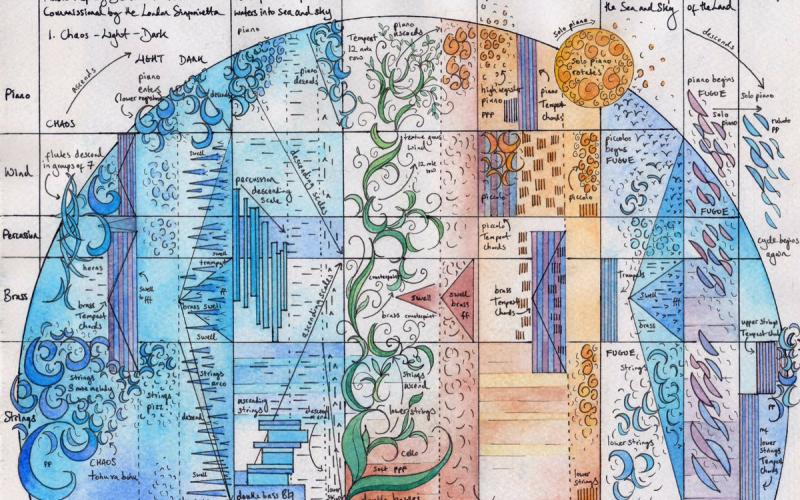Amy Bauer on Thomas Adès’s In Seven Days
Join us for the second lecture of the 2019–2020 UCI Musicology Guest Lectures series. Amy Bauer will speak on A World in Constant Motion: Thomas Adès’s In Seven Days, Thursday, October 24, 4 PM, CAC third floor Colloquium room.
Critic Joshua Kosman called Thomas Adès’s In Seven Days: Piano Concerto with Moving Image (2008) “both dramatic and reflective, by turns ingratiatingly accessible and dauntingly abstruse. It seems to want to embrace the whole world” (Kosman 2015). The concerto outlines the Biblical creation story in seven connected movements, accompanied by coordinated projections by video artist Tal Rosner based on images of the two venues that commissioned the work (London’s Royal Festival Hall and Los Angeles’s Disney Hall). Adès’s conception of Genesis 1:2 follows recent scholarship which suggests that the Hebrew tōhû wābōhû describes not a chaotic, formless void, but rather an unproductive and empty place, to be shaped, ordered, and filled with life (Tsumura 1989, 41–3). As the composer avers, “I was simply telling that story — the story of the material and also of ‘material’, all of it, in the world” (Adès and Service 2012, 31).
In Seven Days merges the figurative and the abstract to parallel modern allegorical readings of Biblical creation. A theme and series of seven variations outline each successive “day”, divided into two halves that appear to follow the framework interpretation of Genesis. This paper will trace the tiny, circling cells that represent the primordial atoms of Day 1 as they accrete into a larger cyclic order in subsequent Days. Register emerges as a structural element in movement 2, when the water is separated into sea and sky, while an undulating passacaglia that branches outward recursively constructs the ‘Land – Grass – Trees’ of movement 3. The ‘Stars’ sparkle high on the piano in movement 4, while overlapping cycles introduce the ‘Sun’ and ‘Moon,’ to close, Messiaen-like, with a cycle in piano. Two great fugues birth ‘The Creatures of Sea and Sky’, and the ‘Creatures of the Land’, lending movements 5 and 6 a sharper profile, yet sounding an apocalyptic note with the introduction of man. The final “day”—a hushed ‘Contemplation’ in strings and piano—ends with a cyclic connection to the first.
The musical allegory presented by In Seven Days suggests a creation shaped as much by implicit scientific principles as the theological notion of a supreme being. The piano functions in this context less as a virtuosic soloist than a guiding force, a “consciousness” that directs the expansion of the work, drives the generation of harmonic and rhythmic patterns, and occasionally arrives, in media res, to comment on the work of creation. A separate musical narrative runs in parallel to the narrative of Biblical creation, one shaped by the refinement of Western musical techniques—such as canon—which themselves display a cyclical history of musical development, from early polyphony through twentieth-century modernism and minimalism. Hence the paper concludes by demonstrating that the “whole world” of In Seven Days embraces a musical creation myth as well.
Image credit Deborah Pritchard
Amy Bauer faculty page
Click here for more information on the musicology lecture series.

